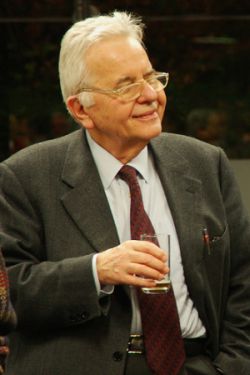
Should Nicola Cabibbo have shared this year’s Nobel prize? (Credit: Marcella Bona)
By Jon Cartwright
There was a reason why science reporters like me groaned at the announcement of the Nobel Prize for Physics yesterday. “Drat,” we thought in synchrony. “Now I have to explain what symmetry breaking is.” Maybe that’s why we on physicsworld.com all hoped for more fathomable research, like dark energy or neutrino oscillations.
For some particle physicists, there was a less selfish reason to be irritated. Two of the three new Japanese-born laureates, Toshihide Maskawa of the Yukawa Institute for Theoretical Physics and Makoto Kobayashi of the KEK lab, were awarded the prize for figuring out how to encompass so-called charge–parity violation in the Standard Model. The crucial part of their work was in describing the decays of quarks, for which they created the CKM matrix — “M” for Maskawa and “K” for Kobayashi. So why did the Nobel committee appear to disregard the first initial — “C” for the Italian physicist Nicola Cabibbo?
Cabibbo did not formulate the CKM matrix itself, though he did lay the groundwork for it. In 1963, almost a decade before Maskawa and Kobayashi made their contributions, the Italian discovered how to describe two distinct decay rates by a four-quark matrix, known as the Cabibbo matrix. The important step made by Maskawa and Kobayashi was to realise that, to account for the observed charge–parity violation, the matrix must be extended to incorporate a third family of quarks. As these quarks — the charm, bottom and top — were discovered over the following three decades, the Japanese physicists’ work gradually set in stone.
I had no luck contacting Cabbibo yesterday, but according to Italian media his colleagues have noticed that he has been somewhat rankled by the Nobel committee’s decision. (Not so silent is Roberto Petronzio, president of Italy’s National Institute for Nuclear Physics, who says he is “filled with bitterness”.) This is understandable — who wouldn’t want a share of 10m kronor? — but Cabibbo’s work, most will agree, is distinct from that of Maskawa and Kobayashi.
There is also the fact that Cabibbo was not the only unsung physicist who contributed to the new Nobel laureates’ work. Jeffrey Goldstone, a British-born theorist, had a big hand in helping Yoichiro Nambu, the third Nobel prize winner this year, to develop the idea of spontaneous symmetry breaking. The Nobel committee has a strict quota of just three awardees per year; there will be disappointments, but not everyone can be honoured.



